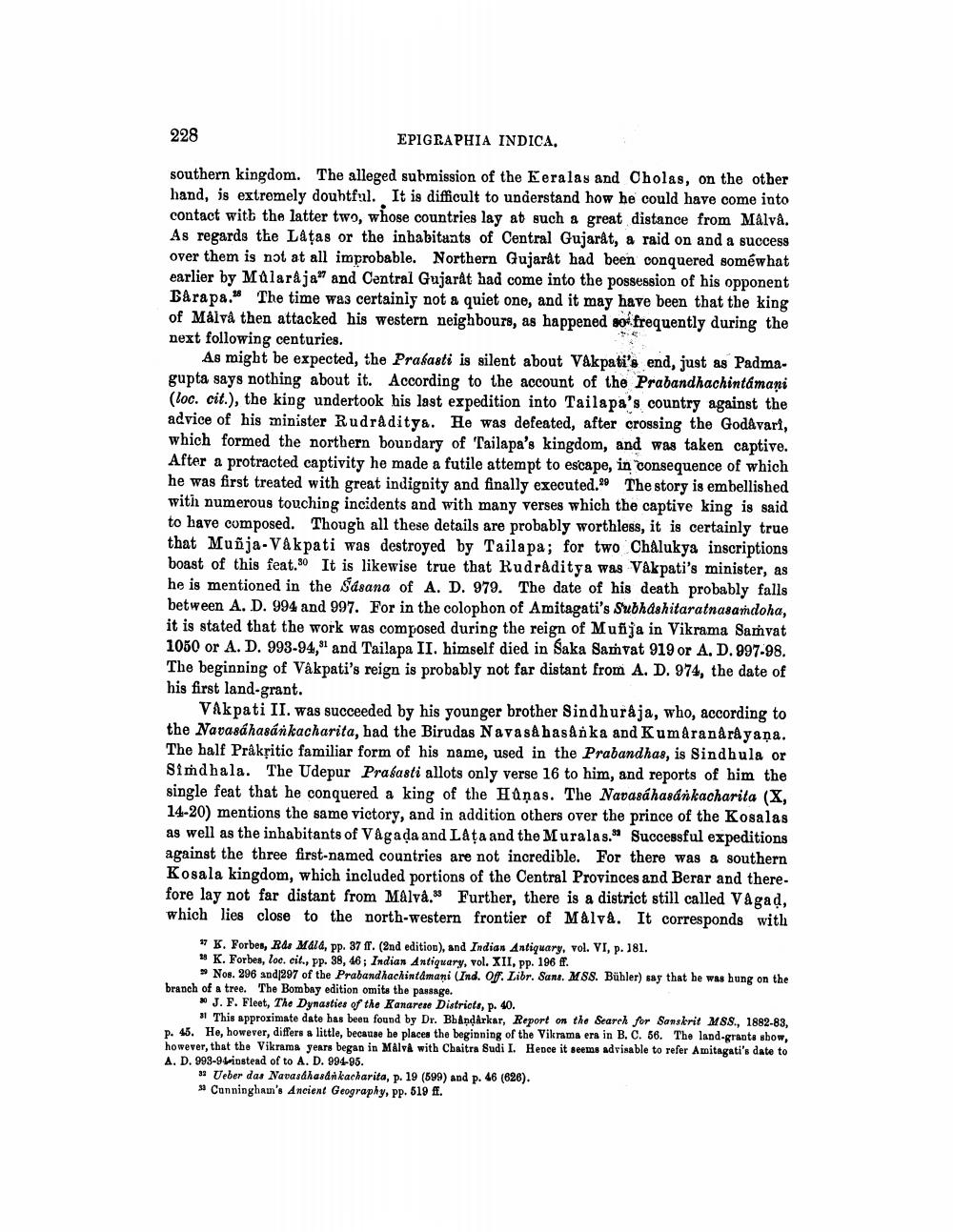________________
228
EPIGEAPHIA INDICA,
southern kingdom. The alleged submission of the Keralas and Cholas, on the other hand, is extremely doubtful. It is difficult to understand how he could have come into contact with the latter two, whose countries lay at such a great distance from Malva. As regards the Latas or the inhabitants of Central Gujarat, & raid on and a success over them is not at all improbable. Northern Gujarat had been conquered somewhat earlier by Malardja" and Central Gujarat had come into the possession of his opponent Larapa. The time was certainiy not a quiet one, and it may have been that the king of Malvå then attacked his western neighbours, as happened 80-frequently during the next following centuries.
As might be expected, the Prakasti is silent about VÅkpati's end, just as Padmagupta says nothing about it. According to the account of the Prabandhachintamani (loc. cit.), the king undertook his last expedition into Tailapa's country against the advice of his minister Rudraditya. He was defeated, after crossing the Godavari, which formed the northern boundary of 'Tailapa's kingdom, and was taken captive. After a protracted captivity he made a futile attempt to escape, in consequence of which he was first treated with great indignity and finally executed. The story is embellished with numerous touching incidents and with many verses which the captive king is said to have composed. Though all these details are probably worthless, it is certainly true that Muñja-Vakpati was destroyed by Tailapa; for two Chalukya inscriptions boast of this feat. It is likewise true that Rudråditya was Vakpati's minister, as he is mentioned in the Sasana of A. D. 979. The date of his death probably falls between A. D. 994 and 997. For in the colophon of Amitagati's Subhashitaratnasandoha, it is stated that the work was composed during the reign of Mufija in Vikrama Samvat 1050 or A. D. 993-94," and Tailapa II. himself died in Saka Samvat 919 or A, D. 997-98. The beginning of Vâkpati's reign is probably not far distant from A. D. 974, the date of his first land-grant.
VAkpati II. was succeeded by his younger brother Sindhuraja, who, according to the Navasá hasánkacharita, had the Birudas Navashasanka and Kumaranarayana. The half Prakritic familiar form of his name, used in the Prabandhas, is Sindhula or Simdhala. The Udepur Prasasti allots only verse 16 to him, and reports of him the single feat that he conquered a king of the Hanas. The Navasáhasánkacharita (X, 14-20) mentions the same victory, and in addition others over the prince of the Kosalas as well as the inhabitants of Vågada and Låta and the Muralas. Successful expeditions against the three first-named countries are not incredible. For there was a southern Kosala kingdom, which included portions of the Central Provinces and Berar and there. fore lay not far distant from Malvå. Further, there is a district still called Vagad, which lies close to the north-western frontier of Malva. It corresponds with
» K. Forbes, Rds Mar4, pp. 37 ff. (2nd edition), and Indian Antiquary, vol. VI, p. 181. 25 K. Forbes, loc. cit., pp. 38, 46; Indian Antiquary, vol. XII, pp. 196 ff.
Nos. 296 and/297 of the Prabandhachintamani (Ind. Off. Libr. Sans MSS. Bühler) say that he was hung on the branch of a tree. The Bombay edition omits the passage.
* J. F. Fleet, The Dynasties of the Kanarese Districts, p. 40.
31 This approximate date has been found by Dr. Bhåndarkar, Report on the Search for Sanskrit M88., 1882-83, p. 45. He, however, differs a little, because he places the beginning of the Vikrama era in B. C. 56. The land-grants show, however, that the Vikrama years began in Málva with Chaitra Sudi I. Hence it seems advisable to refer Amitagati's date to A. D. 993-9 Linstead of to A. D. 994-95.
Ueber das Navasdhasdi kacharita, p. 19 (699) and p. 46 (626). ** Canningham's Ancient Geography, pp. 519 ff.




